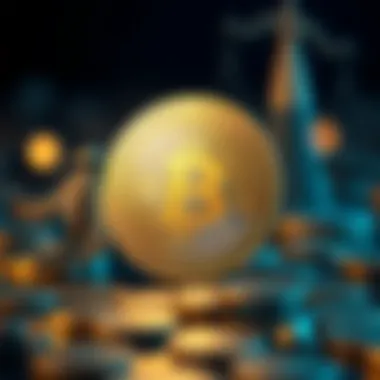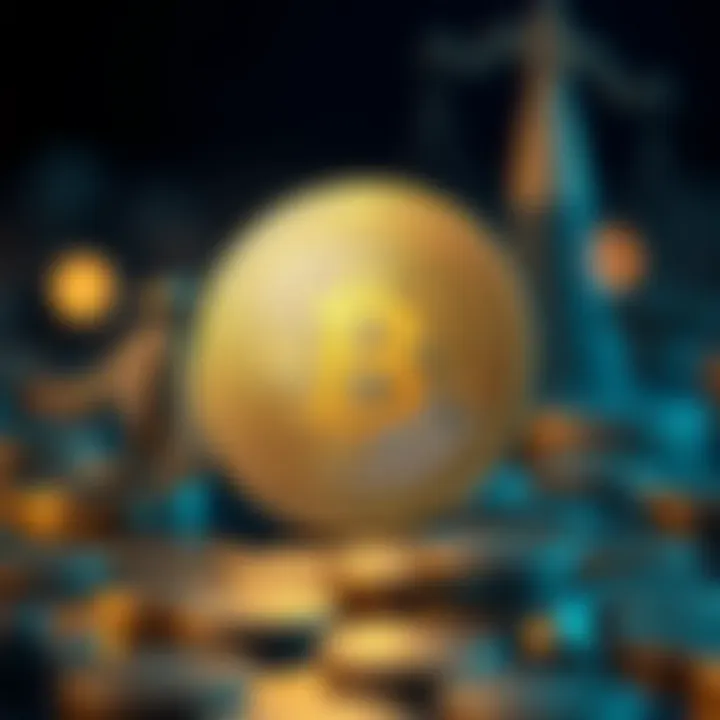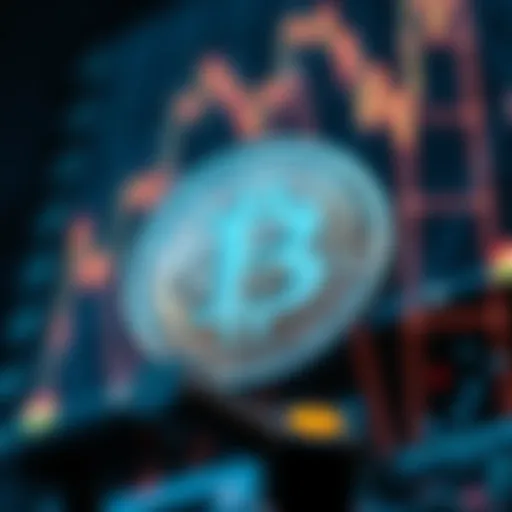Understanding the Minting Process of NFTs


Intro
The digital age has ushered in a new era of creativity, where art, music, and even virtual land can be owned and traded as unique assets. This phenomenon can largely be attributed to the emergence of non-fungible tokens, or NFTs. Unlike cryptocurrencies like Bitcoin or Ethereum, which are interchangeable and share identical value, NFTs offer distinct characteristics that provide proof of ownership for digital items. Understanding the intricacies of minting NFTs is essential not only for artists looking to broaden their horizons but also for investors eager to capitalize on the burgeoning market.
In this article, we will embark on a thorough journey to demystify the minting process of NFTs. This exploration will include a deep dive into the technology driving these tokens, particularly the role of blockchain, and shed light on the implications for both creatives and investors. Moreover, we'll delve into the environmental concerns surrounding this technology, the fluctuating dynamics of market speculation, and the evolving legal landscape that could shape the future of NFTs.
By the end of this narrative, readers will be equipped with a robust understanding of what it means to mint an NFT and the various nuances that accompany this process. Whether you’re an artist or an investor, the insights gained here are likely to deepen your appreciation and strategy in this compelling segment of the cryptocurrency realm.
Preamble to NFTs
In the ever-evolving landscape of digital assets, non-fungible tokens, or NFTs, have emerged as a revolutionary force. They represent a paradigm shift in how we perceive ownership and value in the digital realm. For artists, collectors, and investors alike, understanding NFTs is not just beneficial; it's essential.
NFTs are unique digital representations of assets, fundamentally different from cryptocurrencies like Bitcoin, which are fungible and can be exchanged on a one-to-one basis. When we consider the implications of ownership and the rights associated with digital creations, NFTs offer a wealth of possibilities. This article unpacks these intricacies, focusing on the processes involved in minting NFTs, the underlying technologies, and the implications for a broad audience.
Definition of Non-Fungible Tokens
A non-fungible token, or NFT, functions as a digital certificate of ownership for specific items or pieces of content stored on a blockchain. Unlike traditional currencies, where each unit is interchangeable, NFTs are distinct and can represent anything from artwork to music, virtual real estate, or even tweets. In simple terms, each NFT has its own unique identifier that makes it different from any other token, thus establishing its rarity or value.
Think of it this way: if a Bitcoin is like a dollar bill, an NFT is akin to a one-of-a-kind signed painting. This individuality is what positions NFTs as a game-changer in art and collectibles. NFTs not only serve as proof of ownership but can also encapsulate additional information, including royalty agreements and usage rights.
As the world browses through the digital hallways of art platforms, the simple act of buying an NFT translates into acquiring something genuinely owned, driven by the sense of exclusivity that accompanies it. It’s valuable in terms of sentiment as much as it is in monetary worth.
Historical Background
To understand the relevance of NFTs, we need to journey back to their origins. The first notable instance of a non-fungible token dates back to 2014 with the launch of CryptoPunks, a collection of 10,000 unique pixelated characters created by Larva Labs. Although it didn't capture mainstream attention initially, it set the stage for the future of digital collectibles.
The subsequent advent of the Ethereum blockchain in 2015 enabled more complex programming and established a foundation for smart contracts. Fast forward to 2017, and we saw CryptoKitties, where users could buy, breed, and trade virtual cats. This phenomenon clogged the Ethereum network but also introduced many to the concept of digital ownership through NFTs.
Since then, the explosion of NFTs into fields like art, music, and gaming has been exponential. Celebrities, artists, and brands have jumped on the bandwagon, buying and selling NFTs, leading to eye-popping auction prices that capture headlines regularly.
In the years that followed, platforms like OpenSea and Rarible have consolidated the NFT marketplace, solidifying their relevance in mainstream culture. All the while, conversations about ethics, rights, and the environmental impact of this new digital era have surged within communities and media outlets alike.
The historical context of NFTs provides a lens through which we can better understand their place in today’s digital economy. Grasping this evolution is paramount for any investor or creator looking to navigate the complexities of minting NFTs and capitalizing on their burgeoning market potential.
The Concept of Minting
Minting NFTs is more than just a technical procedure; it's the heartbeats of a digital revolution, particularly within the realms of art and commerce. As the NFT landscape evolves, grasping the concept of minting becomes critically important.
Minting can be likened to forging a unique coin; it imprints its existence on the blockchain, creating an unchangeable identity. Through this process, digital assets are transitioned into the non-fungible realm, turning pixels and bytes into collectibles that can be bought, sold, or traded. It's this transformation that fuels the frenzy around NFTs, particularly for investors and creators alike. The significance lies in the unique characteristics of these tokens, which are irreplaceable and cannot be duplicated, setting them apart from traditional cryptocurrencies.
What Does Minting Involve?
The minting process entails several meticulous steps that must be followed to ensure the digital asset's successful entry into the blockchain. Initially, it’s essential to conceptualize the digital asset— this could be anything from digital art, music, or even virtual real estate.
Here's a breakdown of the minting procedure:
- Creation of the Digital Asset: This involves producing the actual file that will be tokenized. It can be anything from a JPEG, MP4, or even a 3D model.
- Select the Blockchain: NFTs can be minted on various blockchains, each offering unique features. Ethereum is the frontrunner, but blockchains like Tezos and Flow are gaining traction as viable alternatives.
- Utilize a Digital Wallet: A compatible wallet for the chosen blockchain is imperative for holding NFTs, as well as the cryptocurrency needed for transaction fees.
- Engage with NFT Marketplaces: Platforms such as OpenSea or Rarible provide users a way to mint their NFTs effortlessly while tapping into existing markets.
- Minting the Token: The final step involves uploading the digital asset to the blockchain, following which it is transformed into a non-fungible token.
Through this sequence, the digital asset is validated and placed in a public ledger, ensuring its authenticity and ownership.
Blockchain Technology Behind NFTs
At the crux of the minting process lies blockchain technology, rendering it impossible to replicate or counterfeit NFTs. This decentralized system records all transactions and ownership details securely.


Key Elements of Blockchain Impacting NFTs:
- Transparency: Every transaction involving an NFT is logged on the blockchain, making it traceable.
- Security: Given that data is distributed across numerous nodes, tampering becomes incredibly difficult.
- Smart Contracts: These self-executing contracts are coded into the blockchain and execute the terms with no need for intermediaries. They help automate transactions and protect creators' rights.
This technology not only facilitates the creation of NFTs but also ensures their longevity in an ever-volatile digital market, providing assurance to both creators and investors regarding the value and authenticity of their digital assets.
"NFT minting harnesses the power of blockchain to redefine ownership in the digital age, allowing unique assets to have lasting value."
Understanding these facets of minting and the underlying technology is paramount for those looking to navigate the NFT landscape wisely.
For further reading and deeper dives into technical details, check out Wikipedia or Britannica.
Steps in the Minting Process
Understanding the steps in the minting process is crucial for anyone looking to create and sell non-fungible tokens (NFTs). This journey transforms digital assets into unique tokens verifiable on the blockchain, each with its own distinct value and ownership. Successfully navigating this process involves several key components that not only influence the technical aspects but also impact the economic potential of an NFT. Knowledge of these steps can aid artists, investors, and collectors in making informed decisions, ultimately increasing their chances of success in this rapidly evolving marketplace.
Choosing the Right Blockchain
Choosing the right blockchain is like choosing the right foundation for a house; it supports everything built atop it. Various blockchains, each with unique features and capabilities, exist to serve different needs in the NFT ecosystem. Ethereum remains the most popular choice due to its established infrastructure and robust smart contract capabilities. However, alternatives like Binance Smart Chain, Polygon, and Flow also cater to specific niches by offering faster and cheaper transactions. Each blockchain has its own community, tools, and standards, which must be taken into consideration when minting your NFT.
- Transaction fees are often a make-or-break factor. Higher fees can eat into profits, while lower fees may compromise security.
- Environmental concerns are becoming increasingly critical as sustainability gains importance in the public eye.
- Interoperability with other platforms is vital for long-term success as it affects liquidity and access to a broader audience.
When weighing your options, ask yourself questions like: Does the blockchain provide the features necessary for my project? Is the community active and engaged? Understanding these variables can make the difference between a booming success and an underwhelming endeavor.
Setting Up a Digital Wallet
A digital wallet functions like a bank account for your cryptocurrency and NFTs. It is essential for creating, storing, and trading your tokens. Choosing the right wallet involves balancing security and ease of use. Popular options include MetaMask, Coinbase Wallet, and Trust Wallet.
- Create an account: Follow onboarding procedures unique to the wallet.
- Secure your account: Utilize two-factor authentication and strong passwords to protect your assets.
- Add cryptocurrency: Purchase Bitcoin or Ethereum to cover minting fees and transaction costs.
It's vital to watch out for phishing scams. Always ensure you’re downloading wallets from their official websites. Once you set up your wallet, you’re on your way to becoming part of the NFT universe.
Using NFT Marketplaces
NFT marketplaces are frontiers for buying, selling, and trading NFTs. These platforms simplify the process of showcasing your digital assets to a global audience. OpenSea, Rarible, and Foundation are three notable ones, but each functions differently with various user agreements, commission structures, and audience types.
Consider these elements:
- Fees: Understand the fees associated with listing and selling NFTs.
- Audience: Target specific communities by choosing the right platform.
- User interface: Flawless navigation can enhance user experience, making it easier for potential buyers to discover your art.
With a thriving marketplace, your NFT might find the right buyer if showcased effectively. Make sure to follow each marketplace’s guidelines for seamless transactions.
Creating the Digital Asset
Creating the digital asset is where the magic begins. This is the phase where ideas morph into tangible formats, enabling their transformation into NFTs. The digital asset can take various forms, such as artwork, music, videos, or even virtual real estate. The key points to consider are:
- File formats: Each marketplace has specific formats it supports. JPEGs, PNGs, MP3s, and MP4s are common, but researching your chosen platform's specifications is crucial.
- Quality, quality, quality: High-resolution files not only stand out but ensure a better viewing experience for potential buyers.
- Originality: Ownership of copyright matters—a unique creation boosts value.
As you craft your asset, imagine how this piece would fit into the broader NFT landscape. Consider its story and the emotions it evokes. A solid narrative can elevate your digital asset’s desirability.
Minting the NFT
Minting an NFT is the final step where your digital asset turns into a cryptographically secured token on the blockchain. By submitting your asset to the marketplace, you’ll complete the minting process. Each platform varies slightly, but the general steps are:


- Connect your wallet: Link your digital wallet to the marketplace.
- Upload your digital asset: Follow on-screen prompts to load your file.
- Fill in metadata: Add descriptions, attributes, and external links, which enrich the value and context.
- Confirm the minting fee: Carefully ensure you have enough cryptocurrency in your wallet for transaction fees before hitting the mint button.
It’s at this point that your NFT receives a distinct code that establishes its ownership on the blockchain. A successful mint signifies the beginning of your journey as a creator in the NFT space.
Minting is not just a technical process; it is a unique expression of ownership and value in a digital world.
Significance of Metadata in NFTs
In the world of non-fungible tokens, or NFTs, metadata plays a pivotal role. It can be the difference between a digital asset that merely exists and one that truly resonates in the market. This section explores the significance of metadata, looping in key facets like its elements, benefits, and the necessary considerations that come with it.
Understanding Metadata
At its core, metadata acts as information about information. For NFTs, it encapsulates all relevant details about the digital asset, providing context that can enhance its value and function. Without this structured data, a token might lose its essence. Think of it as the label on a wine bottle; it not only tells you what you're drinking but can influence your perception and enjoyment of it. Therefore, grasping the metadata can help investors understand what they are really purchasing.
More specifically, metadata usually contains data points such as:
- Title of the NFT: The name that will be displayed publicly.
- Creator Information: Details about the artist or originator of the asset.
- Description: A narrative or story behind the asset that may attract potential buyers.
- Property Details: Attributes or traits that may make the NFT unique, such as rarity levels.
In simpler terms, metadata provides a roadmap. Investors and creators alike should recognize its foundational importance before entering into any minting activity.
Elements of NFT Metadata
The elements that constitute NFT metadata can often be summed up through various categories, each serving a unique purpose:
- Standardized Attributes: Most NFTs share some common characteristics governed by standards like ERC-721 and ERC-1155, helping to maintain consistency across different platforms.
- Custom Properties: Beyond standardized data, NFT creators frequently include their custom elements. These properties may vary significantly across digital art, music, videos, or virtual land, ensuring that each NFT is not just a token but an intriguing narrative on its own.
- Media Links: Often, metadata will have links to the digital asset itself, whether it’s an audio file, a high-resolution image, or a piece of interactive software. This creates an accessible entry point for potential buyers.
- Ownership History: This acts like a genealogy for an NFT, documenting past ownerships which can reflect its market value. Just as in art, a piece once owned by a famous collector may gain additional worth.
"Metadata isn't just an afterthought; it is the heart and soul of an NFT's value proposition."
The significance of these elements extends beyond immediate perception. In a highly competitive market, distinguishing one's work can create a compelling narrative and could lead to favorable market dynamics for both artists and investors involved.
While the technical aspect of metadata may seem daunting, it offers myriad opportunities for increasing the desirability and authenticity of NFTs. Thus, understanding both the nature and function of metadata becomes crucial for anyone looking to actively engage in the NFT space—be it creators aiming to establish their brand, or investors making calculated decisions in a sea of digital assets.
For further insights and understanding of metadata's breadth, resources like Wikipedia provide a comprehensive take, while platforms such as OpenSea allow practical engagement with existing NFTs.
Economic Implications of NFT Minting
Minting NFTs opens a doorway to a complex economic landscape. This section delves into how NFTs are not just digital collectibles but also players in larger market dynamics. The economic implications surrounding NFT minting can not be ignored as they touch on market behavior, investment patterns, and the livelihood of creators. As the digital landscape evolves, understanding these elements becomes increasingly pertinent for investors and stakeholders in the NFT realm.
Market Trends and Speculation
The NFT marketplace has become a hotbed for speculation, reminiscent of the gold rush. Driven by trends in technology and culture, the market is subject to rapid fluctuations. Hundreds of thousands of NFTs are minted daily, leading to a diverse array of assets ranging from art to virtual real estate.
- Price Fluctuations: Prices can soar or dive overnight based on popularity. For instance, digital art by Beeple sold for $69 million at auction, showcasing how collectors are willing to spend big bucks for unique pieces. However, just as swiftly, lesser-known NFTs may find themselves languishing at lower values, often reflecting the whims of current societal trends.
- Investment Patterns: As retail investors flock to the NFT market, many are driven by fear of missing out (FOMO). This collective psychology has created an environment where temporary trends dictate long-term value. Keeping an eye on what’s trending is essential, as today's hot item may very well be tomorrow’s forgotten relic.
- Market Platforms: Platforms like OpenSea, Rarible, and Foundation play a significant role in shaping market trends. Their governance structures, fee structures, and user experiences can greatly influence where and how NFTs are minted and traded. As these platforms evolve, so too must the strategies of investors and creators.
"The NFT market is like a rollercoaster – thrilling yet unpredictable. One moment you're at the top, the next, it's a steep drop."
Impact on Artists and Creators
For artists and creators, the economic implications of NFT minting are profound. The ability to create, sell, and profit from digital work in unprecedented ways can completely alter their traditional revenue models.
- Royalties: Smart contracts enable creators to earn royalties from secondary sales, ensuring they benefit each time their artwork is resold. This is a game-changer compared to the traditional art market, where artists typically miss out on profits after the initial sale.
- Direct Connection: NFTs allow artists to connect directly with buyers, bypassing galleries and agents. This means more control over pricing and distribution, often resulting in more revenue. Many creators are now examining how they can leverage this direct engagement to cultivate dedicated communities around their work.
- Market Saturation and Visibility: With the influx of creators joining the NFT space, saturation can become a hurdle. Standing out in a crowded market may require innovative marketing strategies and personal branding efforts. Artists will need to find ways to cut through the noise, often leaning into social media and community engagement to ensure their work is seen and valued.
Challenges Faced in the Minting Space


Navigating the intricate world of NFTs is not all smooth sailing. As the landscape continues to evolve, there are a number of challenges that impact creators and investors alike. Understanding these challenges in the minting space is crucial, not just from a technical standpoint but also in terms of ethical considerations and market viability. Given the rapid adoption of NFTs, addressing these challenges helps ensure a more reliable and trustworthy ecosystem for all participants.
Environmental Concerns
The environmental impact of minting NFTs has raised eyebrows in recent years. Much of this concern revolves around the energy-intensive nature of blockchain technology, especially networks like Ethereum, which operates on a proof-of-work consensus mechanism. When creators mint NFTs, a considerable amount of computational power is utilized.
- Energy Consumption: Minting a single NFT can require the same electricity as an average household uses in a week. This has led to criticism from environmental activists highlighting the carbon footprint of blockchain transactions.
- Sustainable Alternatives: Interestingly, there are platforms that employ less energy-intensive methods, like proof-of-stake. But figuring out where to mint without contributing to ecological degradation remains a concern.
As the market grows, the pressure to adopt environmentally friendly practices will likely force change within the NFT space. Ignoring these issues not only jeopardizes public perception but also the longevity of the market itself.
Legal and Copyright Issues
Navigating the legal landscape in the NFT realm can feel like wandering through a minefield. The ambiguity surrounding intellectual property rights can create substantial headaches for creators and investors alike. Misunderstandings can lead to legal disputes, which stifle innovation and deter potential investors.
- Intellectual Property Rights: When a digital asset is minted as an NFT, it’s important to clarify whether the original creator retains copyright or if it is transferred to the buyer. This lack of transparency can lead to confusion.
- Originality vs. Plagiarism: With numerous creators flooding platforms, there's an ongoing risk of plagiarism. People minting NFTs of existing artworks without permission put themselves at risk for infringement claims.
- Jurisdiction Matters: Laws concerning digital assets vary widely across regions. This sometimes makes enforcing copyright laws difficult, leaving artists vulnerable to exploitation.
"Without clear legal guidelines, both artists and buyers are left in the lurch, making careful vetting a necessity in this vibrant but chaotic marketplace."
As the NFT industry matures, establishing clear legal frameworks will be instrumental in resolving issues and fostering trust. Both creators and investors must tune into these challenges to navigate the minting process more effectively.
Future of NFT Minting
As the digital landscape evolves at lightning speed, the future of NFT minting promises to reshape not just the art world but all sectors where uniqueness and originality hold value. This rapid transformation highlights several factors and potential pathways that warrant thorough examination. Understanding this future is crucial for artists, investors, and technologists alike, as it will dictate how NFT technology adapts to meet the ever-increasing demands of its users.
Technological Advancements
Technological advancement is at the heart of NFT minting's future. Wallet technologies are becoming more user-friendly, simplifying transaction processes and making it easier for everyday users to navigate the NFT realm. From frictionless purchasing experiences to enhanced security protocols, advancements are paving the way for broader adoption.
Moreover, tools becoming available for creating NFTs are expanding. Instead of relying on skilled developers, creators can now use platforms designed with intuitive interfaces. These platforms empower artists to tokenize their work without needing deep technical expertise, encouraging more creative minds to join the NFT space.
Another important aspect is scalability. As blockchain technology becomes more efficient, we may witness faster transaction speeds and lower gas fees, making minting NFTs less of a financial burden. Enthusiasts can look forward to innovations that will address the environmental footprint of minting, with some blockchains already exploring carbon-neutral alternatives.
"The only constant in technology is change, and minting NFTs is no exception. The future is more than just possibilities; it's about creating anefficient ecosystem for all participants."
Potential Regulatory Changes
Regulatory frameworks surrounding NFTs are still playing catch-up with the rapidly evolving technology. As governments start to establish guidelines, stakeholders must remain aware of how laws can shape the future of NFT minting. Regulations don't just protect consumers; they also create a foundation for legitimacy and trust in the marketplace.
Expect to see conversations around intellectual property rights and copyright laws becoming central. The ability to verify ownership on the blockchain is powerful, but how it intersects with existing legal structures is less clear. Changes to laws regarding digital assets are inevitable. This could mean needing to align the minting process with the regulatory standards of various jurisdictions.
Moreover, as NFTs gain traction in the mainstream, their treatment in financial regulations, such as tax obligations, will likely become stricter. This need for compliance may lead to the emergence of services designed to help creators and investors navigate the complexities of this landscape.
Navigating these potential changes will be crucial for those involved in the NFT ecosystem, as failure to adapt could result in significant legal implications. The future hinges on the balance achieved between fostering innovation and ensuring public protection.
In summary, as technological advancements pave new paths for creators and investors, the importance of an evolving regulatory landscape cannot be understated. Both elements will significantly influence the trajectory of NFT minting, ensuring it is resilient, inclusive, and ready for the next wave of digital transformation.
Finale
Understanding the process of minting non-fungible tokens (NFTs) is crucial not just for artists and creators, but for investors and market analysts who wish to navigate the rapidly changing landscape of digital assets.
Summarizing Key Points
- Definition and Significance: NFTs represent ownership of unique digital objects, a concept that's revolutionizing how art and assets are perceived and traded.
- Minting Steps: The minting process involves several key stages including selecting a blockchain, creating digital wallets, and using marketplaces to launch assets, which collectively contribute to the successful creation of NFTs.
- Role of Metadata: Attention to metadata is vital as it provides necessary attributes that help to define the NFT and increase its value in the eyes of buyers.
- Economic and Environmental Considerations: The minting of NFTs is tied to economic speculation and has faced scrutiny over environmental impacts, making it essential for stakeholders to stay informed about these aspects as the market evolves.
- Future Development: Technological advancements and potential regulatory changes will continue to shape the NFT landscape, urging participants to adapt to better practices.
Final Thoughts on Minting NFTs
As the digital realm keeps expanding, NFT minting stands as a beacon for creativity and innovation. Every minting action not only creates a new digital asset but also contributes to broader discussions surrounding ownership, rights, and the future of the internet. For investors and creators, grasping the nuances of this process is not just beneficial; it is imperative to thrive in this digital economy.
"The only constant in the world of NFTs is change. Stay agile, informed, and adaptable."
This understanding will pave the path for better decisions and more informed strategies within the burgeoning NFT marketplace.















